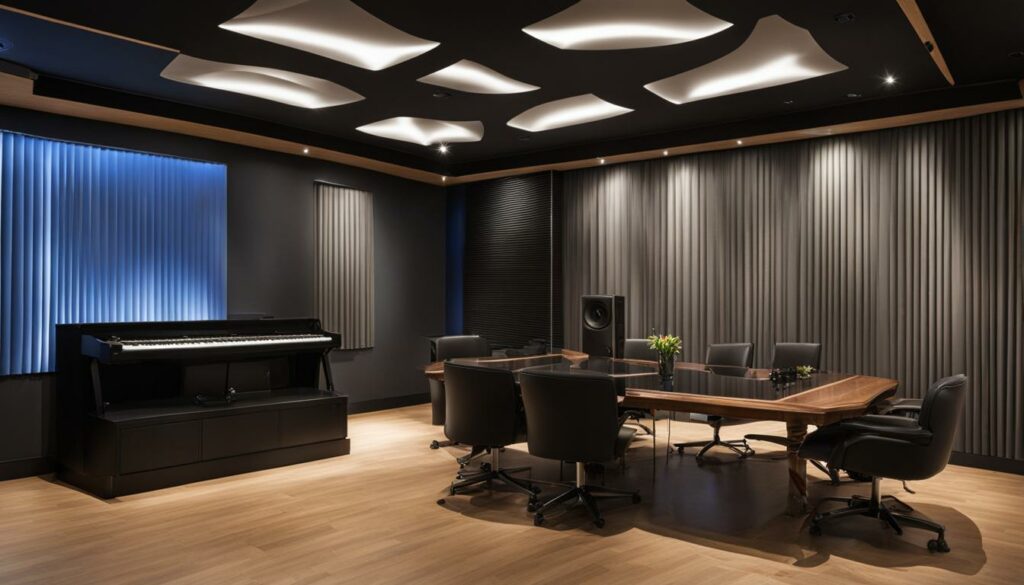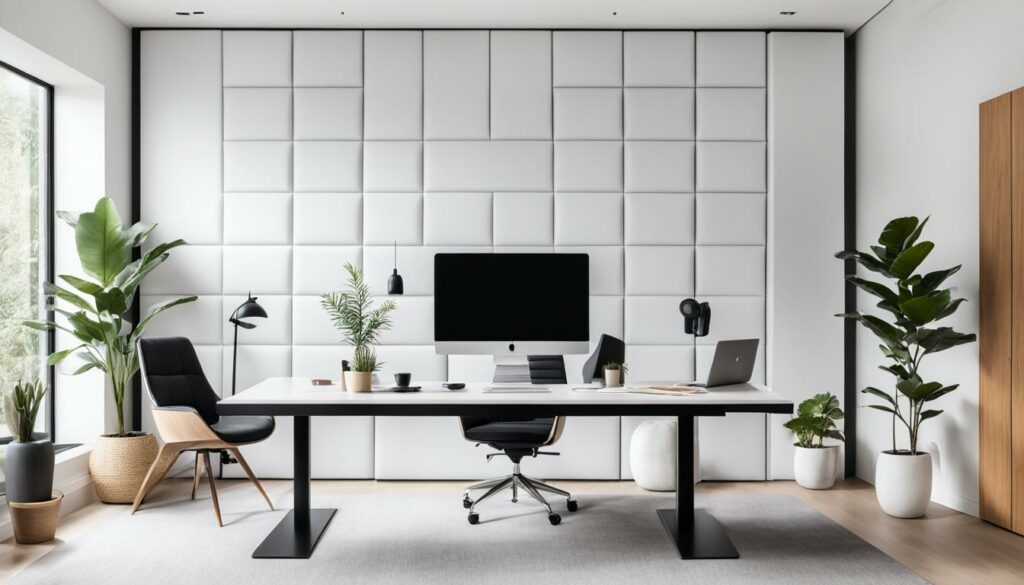When it comes to creating the perfect sound environment, room acoustics play a vital role. Whether you’re a musician, podcaster, or simply someone who values high-quality audio, understanding and implementing effective acoustic treatment techniques can greatly enhance your space and optimize sound quality.
Room acoustics refer to how sound interacts with the surfaces in a space, such as walls, ceilings, and floors. Factors like room shape, construction materials, and the presence of soundproofing materials can all impact the way sound moves through a room.
To optimize your space for better sound quality, it’s important to consider acoustic treatment for rooms. This involves using soundproofing solutions, such as sound absorption panels and other acoustic treatment products, to reduce echo, minimize unwanted noise, and create a more balanced sound environment.
- Room acoustics are crucial for achieving optimal sound quality in any space.
- Factors like room shape, construction materials, and soundproofing solutions impact sound movement.
- Acoustic treatment products, such as sound absorption panels, can help optimize sound quality and reduce echo.
- Implementing soundproofing techniques improves the overall listening experience.
- Consider room acoustics and use appropriate acoustic treatment techniques to create an enjoyable sound environment.
What Are Room Acoustics?
Room acoustics play a vital role in creating an optimized sound environment. To understand how sound behaves in a room, it’s essential to explore the concept of room acoustics.
Room acoustics refer to the way sound travels through an enclosed space. When sound energy is produced, it emits sound waves that radiate in all directions. These sound waves then interact with the surfaces and objects within the room.
There are two main processes involved in room acoustics: sound absorption and sound reflection. Sound absorption occurs when sound energy is absorbed by the surfaces in the room, reducing its intensity. On the other hand, sound reflection happens when sound waves bounce off surfaces and continue to travel through the space.
Understanding how sound absorption and reflection work is crucial in optimizing room acoustics. By strategically placing sound absorption panels in the room, we can control the intensity and timing of sound reflections, reducing echoes and reverberation. This improves the overall sound quality and makes the space more enjoyable to be in.
In summary, room acoustics refers to how sound energy interacts with the surfaces and objects within an enclosed space. By managing sound absorption and reflection, we can optimize room acoustics and create a desirable sound environment.
What Impacts Room Acoustics?
When it comes to room acoustics, several factors come into play. These factors influence how sound behaves and interacts within a space, ultimately affecting the overall sound quality and experience. By understanding and considering these elements, you can make informed decisions to optimize room acoustics.
Room Shape
The shape of a room plays a crucial role in acoustic performance. Different room shapes can result in varying sound reflections and resonances. For example, rectangular rooms tend to have strong resonances and uneven sound distribution, while irregularly shaped rooms may cause sound to scatter unpredictably.
Room Surfaces
The surfaces within a room, such as the flooring, walls, and furnishings, also impact room acoustics. Hard surfaces, like concrete or tile floors, and bare walls can cause sound to reflect and create echos or reverberations. On the other hand, soft surfaces like carpet, rugs, and curtains absorb sound, reducing reflection and enhancing acoustics.
Ceiling Height and Ceiling Panels
The height of the ceiling affects the way sound moves within a room. Higher ceilings can result in a longer reverberation time, while lower ceilings may cause sound to be absorbed quickly. Additionally, the presence of ceiling panels can further affect sound absorption and diffusion, influencing the overall acoustics of the space.
Construction Materials
The materials used in the construction of a room impact its acoustics. Different materials have varying sound absorption and reflection properties. For example, concrete or brick walls tend to reflect sound, while acoustic panels or foam can absorb sound and improve the acoustics of a space.
| Factors | Impact on Room Acoustics |
|---|---|
| Room Shape | Influences sound reflections and resonances |
| Room Surfaces | Affects sound absorption and reflection |
| Ceiling Height and Ceiling Panels | Influences sound absorption, diffusion, and reverberation time |
| Construction Materials | Affects sound absorption and reflection properties |
By considering the room shape, surfaces, ceiling height, ceiling panels, and construction materials, you can make intentional choices to optimize room acoustics. Whether you’re setting up a home theater, recording studio, or conference room, understanding and addressing these factors can help create an immersive and enjoyable sound environment.
Why is Acoustic Design Important?
Acoustic design plays a vital role in ensuring optimal sound quality and volume levels within a room. By considering the materials and construction methods used, we can create a space that maximizes the benefits of acoustic design, resulting in a more enjoyable and immersive audio experience.
One of the key elements of acoustic design is the choice of construction materials. Materials such as concrete and fiberglass insulation are commonly used for their sound reflection and absorption properties. Concrete can effectively reflect sound, preventing noise from transmitting between different areas. On the other hand, fiberglass insulation can absorb sound, reducing background noise and creating a more peaceful environment.
The reflection and absorption of sound are crucial for controlling the acoustics of a room. Reflection refers to the bouncing of sound off surfaces, while absorption involves the dissipation of sound energy. By strategically placing materials that reflect or absorb sound, we can shape the acoustics of a room to achieve the desired sound quality. Reflection can help amplify desired sounds, while absorption can reduce unwanted noise and echoes.
“Proper acoustic design can enhance communication, decrease stress, reduce background noise, and amplify desired sounds.”
Ignoring acoustic design can have negative consequences for the overall quality of a room. Without proper design considerations, there may be a higher level of noise transmission between spaces, resulting in a distracting or intolerable environment. Additionally, poor acoustic design can lead to an unbalanced sound experience, where certain frequencies are overly amplified or masked by background noise.
Overall, the importance of acoustic design cannot be overstated. By incorporating the principles of sound reflection, absorption, and noise reduction into our design choices, we can create a space that optimizes sound quality and enhances our audio experience.
| Benefits of Acoustic Design | Examples |
|---|---|
| Enhanced sound quality | Clear, crisp audio with accurate reproduction of frequencies |
| Improved communication | Reduced background noise allows for easier conversations |
| Reduced stress | A more peaceful and relaxing environment |
| Noise reduction | Minimized noise transmission between rooms or spaces |
How to Improve Room Acoustics for Your Industry
Different industries have unique acoustic requirements for their spaces. By tailoring acoustic treatments to specific industries, you can create optimal sound environments for various purposes.
Hospitals
In hospitals, maintaining confidentiality and reducing noise levels are crucial. Installing ceiling and wall panels and using door seal kits can significantly improve room acoustics in healthcare facilities.
Recording Studios
Recording studios require specialized acoustic treatment techniques to achieve optimal sound quality. Soundproof curtains, drywall with green glue, and soundproof doors can effectively minimize external noise and create an isolated recording environment.
Schools
Creating a conducive learning environment is essential in schools. By using fabric wall panels and implementing sound-buffering products, schools can enhance room acoustics and minimize distracting noises, allowing students to focus better.
Government Rooms
Government rooms, such as meeting rooms and legislative chambers, often face challenges related to noise pollution. The use of Barrier Decouplers and window inserts can help reduce external noise and ensure a more productive and focused environment.

By understanding the specific acoustic needs of your industry and implementing the right solutions such as ceiling and wall panels, door seal kits, soundproof curtains, or window inserts, you can significantly improve the room acoustics in your space, creating an optimal sound environment for your industry’s requirements.
Optimal Acoustic Treatment Options Within Different Budgets
When it comes to acoustic treatment, there are options available to suit every budget. Whether you’re looking for cost-effective DIY solutions or professional-grade panels, there are choices that can enhance the sound quality of your space without breaking the bank.
DIY Treatment and Room Setup
If you’re on a limited budget, DIY treatments using household items can be surprisingly effective. Utilizing blankets, towels, and curtains to absorb sound can make a noticeable difference in room acoustics, and the best part is that it won’t cost you a dime. Additionally, optimizing your room setup by strategically placing furniture and utilizing bookshelves or other surfaces can help to deflect and absorb sound waves, further improving the overall acoustics.
Homemade Solutions
For a budget under $500, you can make your own acoustic panels and diffusers with materials readily available at your local hardware store. These homemade solutions can be a cost-effective option while still providing noticeable improvements in sound quality. With a little creativity and some DIY know-how, you can create acoustic treatments tailored to your space.
Professional Panels
If you have a higher budget, investing in professional acoustic panels can take your room’s sound quality to the next level. Trusted brands such as GIK Acoustics offer a range of acoustic panels designed to address various acoustic issues. These panels are meticulously crafted using high-quality materials to provide optimal sound absorption and diffusion. GIK Acoustics provides expert advice and guidance to help you choose the right panels for your specific needs.
| Acoustic Treatment Option | Budget Range |
|---|---|
| DIY Treatments | $0 |
| Homemade Acoustic Panels and Diffusers | Under $500 |
| GIK Acoustics Panels | Under $1,000 |
In addition to acoustic panels, software like Sonarworks can provide a trusted reference point for accurate monitoring capabilities. By utilizing these tools and treatments, you can optimize your room’s acoustics and create the best sound experience within your budget.
Investing in acoustic treatment is a worthwhile endeavor, whether you’re a musician, podcaster, or simply someone who values high-quality audio. By considering your budget and exploring the various options available, you can find the optimal acoustic treatment solutions to enhance your space’s sound quality and create a more immersive audio experience.

Expert Advice for Acoustic Optimization
When it comes to optimizing room acoustics, expert advice can make all the difference. An acoustics consultant is a valuable resource who can provide the necessary expertise and guidance to achieve optimal results. They possess the knowledge and experience to analyze the acoustics of your space, develop a customized treatment plan, and offer recommendations for speaker placement, addressing acoustic interference, and optimizing room layout.
One of the key benefits of consulting with an acoustics consultant is their ability to conduct acoustic analysis. By thoroughly assessing the unique characteristics of your room, they can identify areas of concern and recommend effective solutions tailored to your specific needs. This comprehensive analysis allows for targeted treatment strategies that address the specific challenges of your space.
In addition to acoustic analysis, an acoustics consultant can also create a customized room treatment plan. This plan outlines the recommended treatments and their placement within your space. By following this plan, you can target problem areas and strategically implement acoustic treatments for maximum effectiveness.
Speaker placement is another critical aspect that an acoustics consultant can provide expert advice on. The proper positioning of speakers within a room can greatly impact the overall sound quality. Whether you’re setting up a recording studio or a home theater, an acoustics consultant can guide you in positioning your speakers to minimize unwanted reflections and optimize sound dispersion.
Acoustic interference can be a significant challenge in achieving optimal room acoustics. An acoustics consultant can identify potential sources of interference and recommend solutions to mitigate their impact. By addressing acoustic interference, you can create a more immersive listening experience with enhanced clarity and accuracy.
Optimizing the layout of your recording studio is another area where an acoustics consultant can provide valuable insights. They can guide you in designing a studio layout that minimizes the impact of external noise and optimizes the positioning of instruments and equipment for optimal sound capture.
Lastly, an acoustics consultant can offer custom treatment solutions tailored to your specific needs. They understand that each space is unique, with its own set of challenges and requirements. By providing custom treatment solutions, they ensure that your room receives the appropriate treatments to optimize the acoustics and create an ideal sound environment.
Whether you’re building a new recording studio or looking to improve the acoustics of your existing space, consulting with an acoustics consultant is a wise investment. Their expert advice, acoustic analysis, custom treatment solutions, and guidance in speaker placement, acoustic interference, and room layout optimization will ensure that you achieve the best possible results in your quest for superior sound quality.
Achieving the Best Sound Quality for Your Space
At [Brand Name], we understand the importance of sound quality and the role it plays in creating an immersive experience. By optimizing the room acoustics and implementing effective acoustic treatment, you can achieve the best sound quality for your space.
One key aspect of creating a high-quality audio environment is achieving a balanced sound. This means ensuring that all frequencies are accurately represented, allowing you to hear every detail with clarity. With optimized room acoustics, you can eliminate any potential imbalances and enjoy a truly immersive sound experience.
Accurate monitoring capabilities are essential for critical listening and producing professional-grade recordings. By optimizing your room acoustics, you can create an environment where you can trust the sound you hear, allowing you to make precise adjustments and capture the true essence of your audio.
“Optimizing room acoustics provides an immersive experience where every nuance of the sound is faithfully reproduced, resulting in professional-grade recordings and the ability to critically listen with confidence.”
Investing in acoustic treatment and optimizing your space can greatly enhance the overall sound quality. By utilizing sound-absorbing materials, diffusers, and proper placement of acoustic panels, you can minimize unwanted reflections and echoes, resulting in a cleaner and more accurate sound.
To help you visualize the impact of room acoustics, take a look at the table below:
| Without Acoustic Treatment | With Acoustic Treatment |
|---|---|
| Unbalanced sound | Well-balanced sound |
| Inaccurate monitoring | Accurate monitoring |
| Unwanted reflections and echoes | Improved sound clarity |
| Limited sound quality | Enhanced sound quality |
By implementing effective acoustic treatment and optimizing your room acoustics, you can elevate the sound quality of your space and enjoy a truly immersive audio experience. Trust [Brand Name] to provide the expertise and solutions you need to achieve the best sound possible.
The Importance of Room Acoustic Treatment
Room acoustic treatment is crucial for creating an enhanced audio experience in any space. By implementing effective soundproofing and absorption techniques, you can optimize the acoustics of your room and elevate the quality of sound. Whether you’re setting up a home office, recording studio, or classroom, investing in room acoustic treatment can have a significant impact on your overall audio experience and the optimization of the space.
One of the key benefits of room acoustic treatment is the reduction of unwanted noise. By utilizing soundproofing techniques, such as acoustic panels, baffles, and foam, you can minimize external noise sources that interfere with your listening experience. This allows for a more focused, immersive audio environment, free from distractions and disturbances.
Improved sound quality is another vital aspect of acoustic treatment. By strategically placing acoustic panels and diffusers, you can minimize sound reflections and echoes, resulting in a cleaner, more balanced sound. This is especially crucial in recording studios, where accurate sound reproduction is essential for producing professional-grade recordings and ensuring an accurate mix.
Acoustic treatment also plays a significant role in absorption, allowing for better control over room optimization. Absorption techniques, such as bass traps and acoustic curtains, help to absorb excess low-frequency energy and attenuate reverberations, creating a more controlled and pleasant sound environment. This is particularly important in rooms with poor acoustics, where excessive reverberation can negatively impact the clarity of speech and music.
Whether you’re a musician, podcaster, or avid audiophile, investing in room acoustic treatment can greatly enhance your audio experience. It creates an optimized sound environment that allows you to fully immerse yourself in the music or audio content, capturing every subtle detail with clarity and precision.
“Room acoustic treatment is like fine-tuning your audio system. It allows you to unlock the true potential of your speakers and ensure an accurate and enjoyable listening experience.”
In conclusion, don’t underestimate the importance of room acoustic treatment. It is a critical step in creating an enhanced audio experience, improving sound quality, and optimizing the space for its intended purpose. Whether you’re seeking to create a professional recording environment, a personal home theater, or a productive workspace, investing in acoustic treatment solutions is an essential aspect of creating a space where sound truly comes to life.
Conclusion
In conclusion, room acoustic treatment is essential for creating an optimized sound environment. By taking into account factors such as room shape, surfaces, and materials, and implementing appropriate acoustic treatments, we can greatly improve sound quality, reduce unwanted noise, and enhance the overall listening experience. Whether you’re a musician, podcaster, or simply someone who appreciates high-quality audio, investing in room acoustic treatment is a worthwhile endeavor that can transform your space and optimize sound quality.
With room acoustic treatment, we can achieve a balanced sound environment and accurate monitoring capabilities for critical listening. This allows us to produce professional-grade recordings and enjoy an immersive audio experience where every detail is heard with clarity and precision. By investing in acoustic treatment and optimizing the acoustics of your space, you can create a truly enjoyable and immersive audio environment.
Don’t underestimate the importance of room acoustic treatment. It is a crucial element in enhancing the audio experience and achieving optimal sound quality. By reducing unwanted noise, implementing soundproofing techniques, and optimizing room acoustics, you can create a space that is optimized for its intended purpose. Whether you’re setting up a home office, recording studio, or classroom, room acoustic treatment is a valuable investment that can greatly enhance the sound quality and overall enjoyment of your space.
FAQ
What is room acoustic treatment?
Room acoustic treatment refers to techniques and solutions used to optimize the acoustics of a space, including soundproofing and sound absorption. It helps improve sound quality and create a more enjoyable listening environment.
What are room acoustics?
Room acoustics refer to the way sound travels through an enclosed space. It involves how sound energy interacts with the surfaces in a room, either through absorption or reflection.
What factors impact room acoustics?
Several factors impact room acoustics, including the shape of the room, the surfaces within it (such as carpet, rugs, furnishings, and walls), the height of the ceiling, the presence of ceiling panels, and the construction materials used.
Why is acoustic design important?
Acoustic design is important because it impacts both the sound quality and the volume levels within a room. Proper acoustic design can enhance communication, decrease stress, reduce background noise, and amplify desired sounds.
How can room acoustics be improved for different industries?
Different industries have unique acoustic requirements. Hospitals can benefit from the installation of ceiling and wall panels and the use of door seal kits. Recording studios require specialized techniques such as soundproof curtains, drywall with green glue, and soundproof doors. Schools can enhance room acoustics with fabric wall panels and sound-buffering products. Government rooms can benefit from Barrier Decouplers and window inserts to reduce noise pollution.
What are some acoustic treatment options within different budgets?
Acoustic treatment options vary depending on the budget. DIY treatments using household items can be effective for those with limited budgets. Homemade solutions, making your own acoustic panels and diffusers, can be cost-effective options. There are also professional acoustic panels and products available at different price points.
Why should I seek expert advice for room acoustic optimization?
Obtaining expert advice from an acoustics consultant can be invaluable in optimizing room acoustics. They can provide acoustic analysis, create a customized room treatment plan, and offer recommendations for speaker placement, addressing acoustic interference, and optimizing room layout.
How can I achieve the best sound quality for my space?
By implementing effective acoustic treatment and optimizing the room acoustics, you can achieve the best sound quality for your space. This includes creating a balanced sound environment, ensuring accurate monitoring capabilities, and producing professional-grade recordings.
Why is room acoustic treatment important?
Room acoustic treatment is essential in enhancing the audio experience in any space. It involves techniques such as soundproofing and absorption to optimize the room acoustics, reduce unwanted noise, and improve sound quality.
What is the importance of room acoustic treatment?
Room acoustic treatment plays a crucial role in creating an optimized sound environment. By considering factors such as room shape, surfaces, and materials, and implementing appropriate acoustic treatments, you can improve sound quality, reduce unwanted noise, and create a more enjoyable listening experience.










